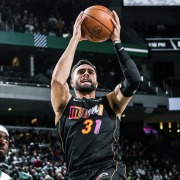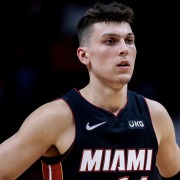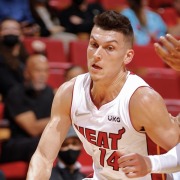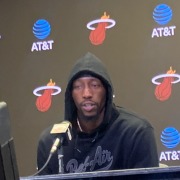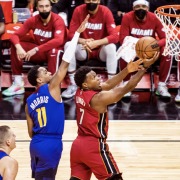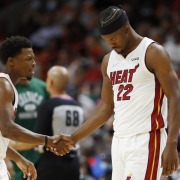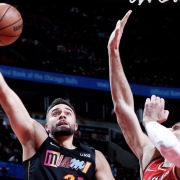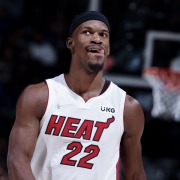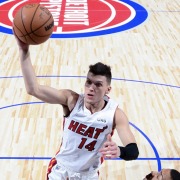The Miami Heat are currently 13-7 to start the season, and it’s been throughout a period of their schedule that was known to be one of the hardest stretches of the season. 13 of the first 20 games have been on the road, and the theme of this Heat team so far this season, is that they’re undoubtedly much better at home.
There have been plenty of team trends that have declined or increased over this span in comparison to prior expectations, but the focus of this piece, as we address everything up to this point, will be surrounded more by schematics. And more specifically, individual players in that area.
So, let’s hop right into what has been seen to begin the year.
Tyler Herro’s mid-range carving, spot-up leap, and separation avenue
Starting an early season wrap up with this Heat team and not mentioning Tyler Herro out the gate would be a terrible way to start. Not because he’s the team’s headliner or best player, but because he’s shifted the outlook on him, plus provided some on-court additions to this offense that have been absolutely necessary.
For one, we’re talking about a guy that is averaging slightly over 21 points a game through this opening stretch of games, but sometimes that can be misconstrued. The reasoning is that many players can come out hot right out the gate then come back down to earth.
But the difference here is that the way he’s doing it is 100% sustainable.
He has slowly mastered every spot of the floor, and what I mean by that is nothing is one-dimensional.
For starters, his mid-range game is by far his biggest strength on the basketball court, just due to the combination of difficult shot-making and improved ways of getting to his spots.
So much talk about if he could change his shot creation in a way where more separation can be created, and he’s done that by adding muscle to his legs in particular, allowing him to rise over the top of any defender in an unblockable fashion.
Three-point shooting has been an issue with this group from a team sense, but Herro has risen in that category as well. After shooting under 40% on catch and shoot threes last season, that has now shot up to 43% at the moment.
Obviously spot-up shooting shifts things for him and this team, but his demanding presence on the ball has made him an even bigger off the dribble three-point threat.
He has put in the work, and it’s paying off on the floor. Drop coverage was always a sign that a big Herro game could be in play, but he’s found ways to make switching defenses pay just as often.
And that’s the true tell between a young player who got hot early in a season, and a young player in the middle of that leap.
Mid-post killers: Jimmy Butler finds his home base, Bam Adebayo still searching for his
The only time we’ve been able to bundle up Jimmy Butler and Bam Adebayo in the same conversation in recent years has been on the defensive end. Both can take over on the end of the floor, and have similar reactions to passing lanes, rotations, and pure perimeter hounding.
But to begin the season, another common thread has been found among these two: offensive positioning.
The Heat have skyrocketed in their post-play, and it’s not the Pat Riley coaching days “post-play” that I’m talking about. Miami occupies that mid-post right inside the wing on almost every possession as a way to get everybody into their spots.
Markieff Morris has found himself there, Kyle Lowry has found his way there once or twice, among others. But clearly, Butler and Adebayo are the sticking points of that section.
Butler has taken off in this new “role,” which hasn’t included much changing. The only offensive shift for him in this spot is less of an urge to play-make, consequently elevating his play to another level immediately.
There’s a reason Butler is top 5 in the MVP race at this time, and it has a lot to do with the spread out floor for him to play in isolation, get to the rim, get to the free throw line, and well, knock down that mid-range jumper that’s been falling all season so far.
For Butler, that is his home-base.
Adebayo, on the other hand, has caused many discussions about his offensive role with this new team, and I think that speaks volume. When in that mid-post spot, should it be more inside post-play scores? Should he face-up into that jumper? Should he rely on play-making for others?
In many ways, the simplification for him hasn’t been as seamless as that for Herro in his bench role.
For what it’s worth, Adebayo has had a great start to the season numbers wise, and continues to be that defensive glue for Miami’s top 4 defensive rating. But as we know, there’s still much more to untap with him.
With all of that said, Adebayo must find his home-base in that mid-post. In my personal opinion, he looks most comfortable in that face-up game where he can pick his spots and utilize his biggest offensive strength against bigger defenders: his speed.
Both of Miami’s top dogs are mid-post killers, but only one of them has totally felt right at home. It’s coming for Adebayo, since not everything just works out perfectly through 20 games of basketball in this league.
Kyle Lowry and Duncan Robinson simply awaiting for 3’s to fall, but could new perimeter spotting be on the way?
The shooting of Duncan Robinson has probably been the biggest worry among Heat observers to begin the season, and Kyle Lowry is right behind him. The team has transformed into a fully three-point shooting team to a group that has a “good shooting night” when they shoot above 30% from beyond the arc.
Herro’s kept them afloat. PJ Tucker’s kept them afloat. But Robinson and Lowry have been the anchored forces to them being a middle of the pack 3 point shooting team.
So much has been discussed about this specific topic, but now that we’re 20 games in, some slight changes in exact offensive positioning should be on the way. Lowry and Robinson each shot 42% on catch and shoot threes last season, which is now at 29% and 32% respectively.
Yes, things will come back to normal sooner or later, which has already come into fruition in the 20th game in Chicago, but in the meantime, weak-side operation can’t continually be the answer. Through a quarter of the season, it’s been a ton of Robinson awaiting the ball to fall into his lap, which has not been him at any point of his NBA career.
He needs to seek that ball out, receive more high pick and roll reps which transformed his shooting last season, and continually make that pocket pass as defenders continue to double out at him no matter his shooting percentages.
Lowry, on the other hand, needs to get back to his usual ways. More transition pull-ups like his days in Toronto, more quick pulls after sliding across the pick at the top of the key, and more corner spotting.
Could it almost mean Robinson and Lowry switching roles at times?
Lowry in the corner should be used more down the stretch of games, which have been a struggle. The reasoning is that no defender is dipping far off Lowry on that baseline, and Robinson on the strong-side of plays have shown to be a cheat code over the years.
Up to this point, those two have almost been flipped in that type of usage.
Either way, it all comes down to making open shots. And if the team’s biggest problem through 20 games of basketball is Duncan Robinson and Kyle Lowry consistently making an open gym triple, then they’re sitting in a great spot.
 Loading...
Loading...Defensively: soft switching worries, individual match-up dominance, and additional creative options
This has been pretty offensive centric so far in this piece, but with this Heat team, I don’t know if that’s very fair to initially project. The Heat are currently 4th in defensive rating so far this season, and as you scroll through your favorite social media app, you would probably think it was the exact opposite.
A main reason is that when it comes to defense, poor defensive possessions stick out more than good ones. So Robinson or Herro getting picked on in isolation may immediately jump off the screen, but their positioning on the weak-side on the play before isn’t mentioned once.
I bring this up because that’s been the case with the Heat’s soft switching so far. It’s 100% problematic many nights when the opposing team has talented perimeter players who can pick out mismatches, meaning Lowry, Robinson, or Herro is fighting for their hypothetical life down on the block against 7 foot monsters.
It’s also why they allow so many threes, since the soft switch basically gives ball-handlers a half-second to pull when a screen comes, or allows a screener to slip to cause mayhem defensively. And when teams capitalize like the Wizards did in Miami’s loss, it just plainly stands out.
There are solutions to anything that is thrown at you at the NBA level, but it’s why Spo has so many things up his sleeve. Guys like Gabe Vincent and Caleb Martin have played their roles even better than originally expected, just due to the defensive strategy based around them.
A 2-2-1 press backed into a 2-3 zone has been the cure for fast offensive teams many nights. But what do you think gets discussed more, those adjustments or the soft switching?
Like I said before, they’re definitely going to have to tweak it slightly though, just because this is a team that won’t fully die-out on screens and can handle most individual match-ups. PJ Tucker can essentially guard 1 through 5, Butler’s playing some of the best weak-side defense of his career, and Adebayo is still up there for DPOY.
The point is that this team has been a major defensive force in this early span of games, and more flaws have been recognized than strengths. That’s the formula for a team with true elite defensive potential.
PJ Tucker’s short roll and corner worries shifting the offense
Herro has exceeded expectations for sure, but not to the level that PJ Tucker has to kick off the season. Usually young players are the only ones that can truly shift a pre-season projection, but Tucker has taken that to another level.
We know who he is as a player. A major defensive threat, which as I said, can defend positions 1-5. He plays bigger than his 6 foot 5 height, mostly through rebounding by becoming one of the best box-out guys in the league. But with all that said, the reason the number on his deal was a bit slimmer than you’d expect is due to the offensive limitations.
But those have quickly vanished.
After shooting 32% on catch and shoot threes last season, it has spiked to 45% to begin the year.
As I stated earlier, he has essentially leveled off the poor shooting of Miami’s starting back-court, which was in no way an expectation coming in. The thing about that though is it’s not just about that high percentage or the number of attempts he’s putting up.
But it’s actually the pull he currently has on defenses. When you’re best players thrive off open lane drives, and isolation frequency rises, you need that corner defender to think twice before going for the tag. And that has been the case many plays up to this point.
He’s also making them pay in a totally off the wall position of the floor on the offensive end: a roll and float. Running hand-offs and setting screens is no surprise in his role with the way Coach Spoelstra describes him as one of the league’s best screeners, but it’s what comes next.
Two flash to Robinson, he hits Tucker in the pocket, and you worry about what comes next. Do you want a limited power forward running the 4 on 3 on the back-side? Well, now you do.
Tucker gets to the middle of the floor, rises with two feet off the floor, and flicks up a right handed floater. Bucket.
That’s become his staple, and it’s gotten Miami out of a bunch of sticky situations. A 36 year old veteran should not be adding to his bag in this way, but he truly has in this not-so-similar role around this stable group.
Exceeding expectations is one thing. But taking over games in more than just the rebounding column or defensive metrics is another.
Everything Tradeshows is a one-stop-shop for trade show exhibit rentals and custom exhibit display purchase solutions to companies of all sizes.
Visit them at EverythingTradeShows or call 954-791-8882
